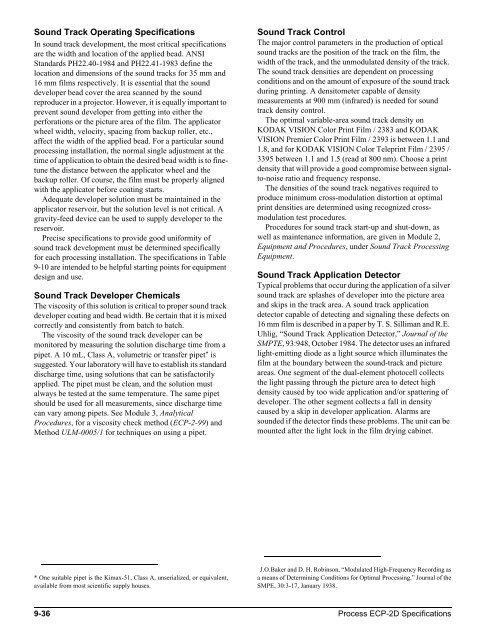films and process sequence ... - Kodak
films and process sequence ... - Kodak
films and process sequence ... - Kodak
You also want an ePaper? Increase the reach of your titles
YUMPU automatically turns print PDFs into web optimized ePapers that Google loves.
Sound Track Operating Specifications<br />
In sound track development, the most critical specifications<br />
are the width <strong>and</strong> location of the applied bead. ANSI<br />
St<strong>and</strong>ards PH22.40-1984 <strong>and</strong> PH22.41-1983 define the<br />
location <strong>and</strong> dimensions of the sound tracks for 35 mm <strong>and</strong><br />
16 mm <strong>films</strong> respectively. It is essential that the sound<br />
developer bead cover the area scanned by the sound<br />
reproducer in a projector. However, it is equally important to<br />
prevent sound developer from getting into either the<br />
perforations or the picture area of the film. The applicator<br />
wheel width, velocity, spacing from backup roller, etc.,<br />
affect the width of the applied bead. For a particular sound<br />
<strong>process</strong>ing installation, the normal single adjustment at the<br />
time of application to obtain the desired bead width is to finetune<br />
the distance between the applicator wheel <strong>and</strong> the<br />
backup roller. Of course, the film must be properly aligned<br />
with the applicator before coating starts.<br />
Adequate developer solution must be maintained in the<br />
applicator reservoir, but the solution level is not critical. A<br />
gravity-feed device can be used to supply developer to the<br />
reservoir.<br />
Precise specifications to provide good uniformity of<br />
sound track development must be determined specifically<br />
for each <strong>process</strong>ing installation. The specifications in Table<br />
9-10 are intended to be helpful starting points for equipment<br />
design <strong>and</strong> use.<br />
Sound Track Developer Chemicals<br />
The viscosity of this solution is critical to proper sound track<br />
developer coating <strong>and</strong> bead width. Be certain that it is mixed<br />
correctly <strong>and</strong> consistently from batch to batch.<br />
The viscosity of the sound track developer can be<br />
monitored by measuring the solution discharge time from a<br />
pipet. A 10 mL, Class A, volumetric or transfer pipet * is<br />
suggested. Your laboratory will have to establish its st<strong>and</strong>ard<br />
discharge time, using solutions that can be satisfactorily<br />
applied. The pipet must be clean, <strong>and</strong> the solution must<br />
always be tested at the same temperature. The same pipet<br />
should be used for all measurements, since discharge time<br />
can vary among pipets. See Module 3, Analytical<br />
Procedures, for a viscosity check method (ECP-2-99) <strong>and</strong><br />
Method ULM-0005/1 for techniques on using a pipet.<br />
* One suitable pipet is the Kimax-51, Class A, unserialized, or equivalent,<br />
available from most scientific supply houses.<br />
Sound Track Control<br />
The major control parameters in the production of optical<br />
sound tracks are the position of the track on the film, the<br />
width of the track, <strong>and</strong> the unmodulated density of the track.<br />
The sound track densities are dependent on <strong>process</strong>ing<br />
conditions <strong>and</strong> on the amount of exposure of the sound track<br />
during printing. A densitometer capable of density<br />
measurements at 900 mm (infrared) is needed for sound<br />
track density control.<br />
The optimal variable-area sound track density on<br />
KODAK VISION Color Print Film / 2383 <strong>and</strong> KODAK<br />
VISION Premier Color Print Film / 2393 is between 1.1 <strong>and</strong><br />
1.8, <strong>and</strong> for KODAK VISION Color Teleprint Film / 2395 /<br />
3395 between 1.1 <strong>and</strong> 1.5 (read at 800 nm). Choose a print<br />
density that will provide a good compromise between signalto-noise<br />
ratio <strong>and</strong> frequency response.<br />
The densities of the sound track negatives required to<br />
produce minimum cross-modulation distortion at optimal<br />
print densities are determined using recognized crossmodulation<br />
test procedures.<br />
Procedures for sound track start-up <strong>and</strong> shut-down, as<br />
well as maintenance information, are given in Module 2,<br />
Equipment <strong>and</strong> Procedures, under Sound Track Processing<br />
Equipment.<br />
Sound Track Application Detector<br />
Typical problems that occur during the application of a silver<br />
sound track are splashes of developer into the picture area<br />
<strong>and</strong> skips in the track area. A sound track application<br />
detector capable of detecting <strong>and</strong> signaling these defects on<br />
16 mm film is described in a paper by T. S. Silliman <strong>and</strong> R.E.<br />
Uhlig, “Sound Track Application Detector,” Journal of the<br />
SMPTE, 93:948, October 1984. The detector uses an infrared<br />
light-emitting diode as a light source which illuminates the<br />
film at the boundary between the sound-track <strong>and</strong> picture<br />
areas. One segment of the dual-element photocell collects<br />
the light passing through the picture area to detect high<br />
density caused by too wide application <strong>and</strong>/or spattering of<br />
developer. The other segment collects a fall in density<br />
caused by a skip in developer application. Alarms are<br />
sounded if the detector finds these problems. The unit can be<br />
mounted after the light lock in the film drying cabinet.<br />
J.O.Baker <strong>and</strong> D. H. Robinson, “Modulated High-Frequency Recording as<br />
a means of Determining Conditions for Optimal Processing.” Journal of the<br />
SMPE, 30:3-17, January 1938.<br />
9-36 Process ECP-2D Specifications

















